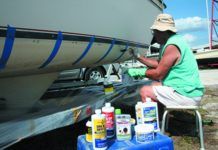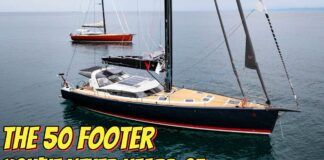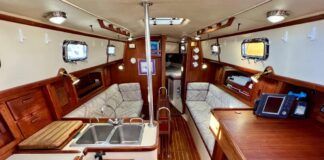Athreaded backing plate is a common approach to eliminating nuts in through bolts. We’ve used threaded backing plates for mounting jammers to thin-walled spars by using a string to “fish” backing plates into position (see “A Smart Easy Way to Rewire,” PS April 2020). We’ve installed backing plates for winches and genoa tracks backing plates in a similar fashion, using stiff rigging wire at one end of the backing plate and a yardstick taped to the other to slide the backing plate under the liner.
When choosing a backing plate, remember that a stainless-steel backing plate must be at least 60 percent as thick as the fastener’s diameter. An aluminum plate’s thickness must be 75-percent of the fastener’s diameter. Thinner material simply won’t provide enough threads. To prevent corrosion, coat the threads with an anti-seize product such as TefGel or Loctite LB 8023 (see “Anti-Seize Coatings for Spars,” PS July 2018).
EMBEDDED BACKING PLATES
Production boats often incorporate threaded aluminum plates embedded within the deck laminate because it simplifies deck hardware installation. Leaks won’t damage the core since the plates are installed into solid laminate.
However, when the hardware bedding gets old, leaks can allow saltwater into the aluminum backing plate, causing corrosion. Unless the bolts have been protected with anti-seize, they will eventually seize, requiring you to drill and tap new holes, or replace the entire backing plate. Stainless steel plate, deprived of oxygen in the laminate, will also corrode (see “Marine Metal Warning,” PS February 2007). If you have an old boat with embedded plates, you probably need to reapply anti-seize.
SELF-TAPPING FASTENERS
A self-tapping fastener can’t handle high loads like a through bolt, but they’re fine when used properly.
If you must replace a self-tapping screw, follow the original threads that are already cut into the screw hole—don’t cut new threads. To do this, lightly turn your new screw counterclockwise until you feel the “click” of the fastener passing over the original thread. At that point you can lightly turn the screw clockwise and follow the original thread. Cutting fresh threads into plastic or wood each time you remove or service an item will quickly wear out the hole. Plastic pumps on marine heads commonly fail because new threads are cut each time they are reassembled.
In general, we don’t like using self-tapping screws in aluminum spars. Unless the spar has been completely stripped of internal wire and running rigging, there is simply too great a chance of snagging a line or cutting a wire with the fastener. We’d rather tap the spar for a bolt, use a threaded backing plate, or use blind rivets or Rivnuts (see “Through Bolt Alternatives”).
On cored decks, self-tapping screws have very limited holding capacity. They can also be difficult to bed and are a leading cause of core saturation. Both shortcomings can be partially addressed by removing core and filling with a fiberglass-reinforced epoxy plug (see “A Stronger Screw Hole Repair,” PS June 2020).







































